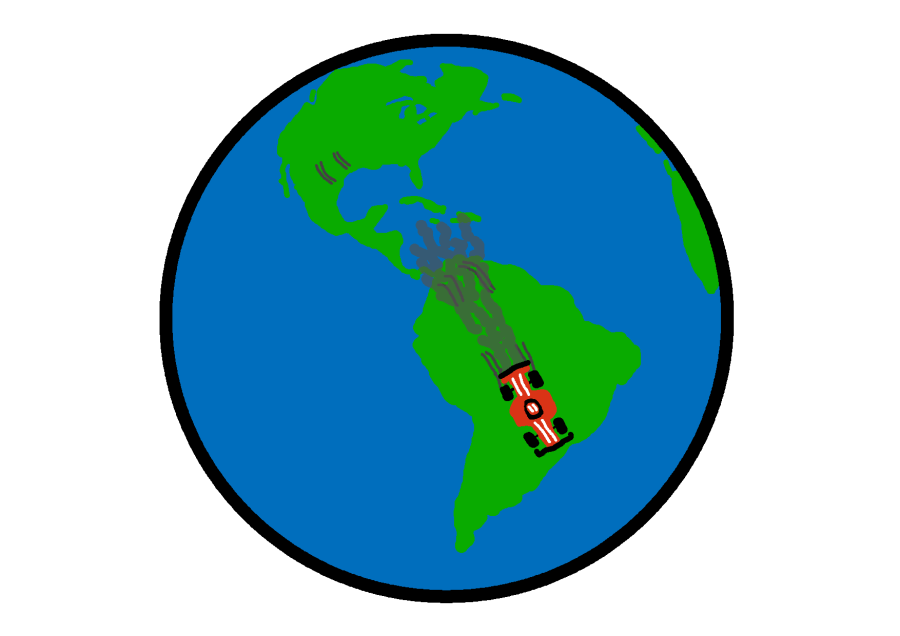A global motor sport that’s fit for the world
Rewriting the F1 calendar with the athletes, fans and the earth in mind
Illustration of an F1 car racing around the earth with smoke coming out of it
In recent years, the Formula One World Championship has seen its schedule grow exponentially, with new races worldwide. The championship features global races in exciting venues such as Miami, Belgium’s Ardennes Forest, former World War II air bases in the United Kingdom, the streets of Singapore and Monaco and many more.
However, the current schedule is incredibly wasteful. Teams make frequent globe-spanning trips when traveling to a neighboring country would be more efficient. Fans have complained about the travel surrounding the sport for years, as they sometimes experience brutal double-headers — two races in two weeks. One of the worst double-headers in 2023, the trip from Baku, Azerbaijan to Miami, USA, makes teams and drivers fly over 9,000 miles in a single week.
In a perfect world, the calendar would allow fans to see their favorite drivers on the biggest stage without having the nasty cloud of logistics hanging over them. However, this is simply not the case for several reasons. Stubborn organizers, climate and tradition all play a part in the F1 calendar, much to the chagrin of fans and teams alike. For the purposes of this article, however, the organizers aren’t a concern to help create the “perfect” 2023 schedule. This allows us to hypothesize when and where the races should go to highlight the climate-conscious possibilities of the sport.
March: The Middle East
Since 2021, Bahrain has hosted the opening round of the championship. In this timeline, three middle eastern races will take place at the start of the season, with Bahrain taking the season opener on March 5. After the race, the teams will quickly jump over the border to Qatar on March 12 before traveling to the United Arab Emirates on March 19 to hit the triple-header to open the year. Though Saudi Arabia has a race on the 2023 calendar, issues surrounding security and the track itself have led to this track’s removal for the hypothetical season.
April – May: Asia & Africa
Following a week-long break, F1 returns to the land down under, the traditional home of the season opener prior to COVID cancellations. Albert Park in Melbourne, Australia, plays host to round four on April 2.
After another week break, the F1 circus returns to the glitz and glamor of Marina Bay, Singapore on April 16. This will be the fourth night race in the first five rounds, which will cause some burnout among fans, but it will make early-season viewing easier for those in Europe and the United States.
After Singapore, F1 travels to the Suzuka Circuit in Japan for one of the most classic circuits in F1 history. This three-race stretch will be tough on European staff, but it will result in a more climate-friendly season, as races are closer to each other, using less fuel overall.
After another week-long break, the calendar will make a pit stop in South Africa on May 7 for the first time since 1993. Though Kyalami is not on the official 2023 F1 calendar, it is vital that the sport return to the continent in order to be considered a “World” championship once again. After Africa, teams will get a week off to rest before the European stretch — and the intensity of the season — hits.
May – July: Europe, part one
The European Season starts with the Spanish Grand Prix on May 21, with Monaco returning to its traditional Memorial Day spot. Following another break, Italy gets back-to-back races in Monza and Imola on June 11 and 18, respectively. Another triple-header will send the drivers to Austria on July 2, Hungary on July 9, and Azerbaijan on the 16.
August: Europe, part two
Following the three-week summer break, the Ardennes Forest’s Belgian Grand Prix plays host to Round 15 on Aug. 13 —starting the final triple-header of the season. After a trip to the Netherlands on Aug. 20, the United Kingdom hosts Europe’s last race: the British Grand Prix on Aug. 27. These races, though staples of the June months, will likely see incredible action as the series navigates the dog days of summer at some of the most iconic venues in motorsports.
September – November: Going West
With F1’s European portion of the season finally finished, the final six races will take us to the Western Hemisphere. Montreal, Canada hosts Round 18 on Sept. 10 — a bit later than usual but still early enough in the year where the weather shouldn’t be a concern.
After a one-week break, the American stretch starts with a trip to Miami, Florida, on Sept. 24. A double-header takes us to Las Vegas, Nevada, on Oct. 1; another week-long break gives us a trip to Austin, Texas, on Oct. 15.
After another pause, the penultimate round takes us to Mexico City, Mexico, and Autodromo Hermanos Rodriguez on Oct. 29. The final break of the season sits before the last race, with the season-ending race at its rightful home: the Autodromo José Carlos Pace in São Paulo, Brazil, on Nov. 12.
Though this is not mathematically the perfect calendar for distance, it is limited by the regional climate and time of year. No one wants to race in the Middle East in the summer, and no one wants to have a race in Canada in November. Also, the eagle-eyed viewers will notice that the real-life Qatar Grand Prix was replaced by Kyalami, who is not a member of the F1 calendar.
This move was made for two reasons. Firstly, as of writing, Kyalami has reportedly been considered for a bid on the 2024 calendar, raising hopes that F1 will return to the continent sooner rather than later. In addition, if Qatar was a member of the calendar, the season’s first four races would be a quadruple-header, which has yet to be attempted in F1 history. Because there are already three triple-headers on the schedule instead of the two in F1’s present schedule, the motion for a quadruple-header to open the year would be political suicide for any team principal brave enough to suggest it.
Unfortunately, this will never happen. Though the schedule looks great on paper, it needs to consider the daily lives of those with families worldwide to come home to during the week. Despite the unrealistic expectations of a “perfect” season, it’s fun to dream.

Hey! I'm Caleb Reed, and I'm the new Sports Editor for the Trinitonian this year. I love all kinds of sports and I've got a passion for both commentary...

I'm Tony Rodriguez! I'm a junior from San Antonio, TX, majoring in math, and I worked as a copy editor for the Trinitonian about two years ago and am now...










